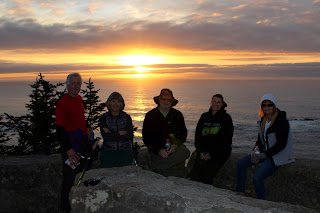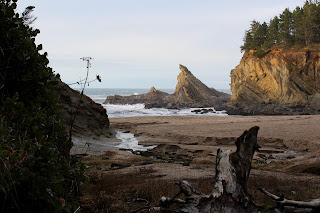Last hike of the year! (Disclaimer: even though I am writing and posting this entry in mid-February 2018, the hike was actually done last year. Confusing, I know, but I am way behind!). Traditionally, the hiking club always closes out each year with a hike in the North Bank Deer Habitat and 2017 would be no different. One unique feature of this year's version was that yours truly was tabbed to lead the hike and since I prefer not hiking the same route over and over again, the normal route was changed up a bit as we hiked up Soggy Bottoms Road and came down East Boundary Ridge. Nobody complained through, because the route could have gone up the incredibly steep East Boundary Ridge for 4.3 miles instead of coming down it like we did.
 |
| Drip, drip, drip... . |
It was chilly at the beginning but not quite icy. The habitat was socked in with fog that muffled sound, sight, and mental acuity alike. Soggy Bottoms Road was just that: soggy and at the bottom of a valley. Soon our boots were coated in mud which is normal when hiking in the habitat in winter or early spring. I'd say the views were nice but you had to squint really hard just to barely perceive the outline of the nearest hill somewhere in the dense fog.
 |
| The views were less than expansive |
The expectation was that as we climbed out of Soggy Bottoms, we'd be hiking out of the fog and into a sunny day but that never quite panned out, for the day could never really decide whether to be sunny or foggy. There were times where we enjoyed ample sunlight and there were times where we looked nervously around, halfway expecting a North Bank version of Jack the Ripper to materialize out of the soupy mist.
 |
| Rays of hope gave us hope |
As normal, our hiking party of 9 separated into two groups: fast hikers and photographers, where "photographer" is used as a synonym for "slow hiker" in this context. I'll leave it to the reader's imagination as to which group I was in, although I will point out I do carry a camera. Anyway, by the time us laggards reached Grumpy's Pond, we were far behind the speedsters. Gaoying was waiting for us at the pond, welcoming us with a sarcastic "I thought you guys had stopped for lunch!". I believe "stopped for lunch" was used in this context as a synonym for "slower than sloths".
 |
| Why we hike |
At the crest atop the North Boundary, the heavy fog lifted, the sun came out, and we enjoyed the usual great views from the habitat's higher reaches. A spectacular rainbow arched over us and we could actually see the end of the rainbow touching down upon the trail. The rainbow was so spectacular, we didn't really care that there was no proverbial pot of gold.
 |
| Ghostly snag in the ghostly mist |
The habitat is a working ranch still, and we had to pass a series of gates to get past the electrical fences marking the cattle range. Yow! One such fence bit me and my empathetic companions doubled over in hysterical laughter when I yelped with pain. Very funny, guys, but I would have done no different had it been anybody else besides me shaking hands with Freddy Kilowatt.
 |
| Mist in the valley |
Now on the East Boundary Ridge, the trail descended for the next 4 miles. "Descended" is a misleading term though, as there were a number of steep uphill pitches to surmount even though we were in theory losing elevation, but such are the trails in the North Bank. We enjoyed ample sunlight on the ridge while a thin and patchy mist still filled up the valleys below.
 |
| Scraggly oak, a common sight in the Habitat |
Below us, the North Umpqua River glinted in the noonday sun as it perambulated around Whistlers Bend. The river was flanked by a patchwork quilt of bright green pastures and farms, a few of them bisected by the unerringly straight North Bank Road. A small herd of cattle flanked the trail and we "enjoyed" a nice view of how cattle poop gets made, where "enjoyed" means "not really". We made sure to step around the cow bombs on the trail and no boots were harmed in the hiking of this hike.
 |
| Trail atop East Ridge |
Because of an illness in my family, I didn't do a lot of hiking early in the year and had grudgingly consigned myself to a lesser year, in terms of hiking miles; not that any of that mattered in the face of what we were dealing with. However, at the start of this hike, I was only a half-mile away from reaching 400 miles for the year. The final 2017 stats are 408.3 miles, 57 hikes, and a 7.2 mile per hike average, not too bad at all. This last hike in the North Bank left me cautiously optimistic for 2018 and let's all please enjoy a catastrophe-free 2018.
 |
| The North Umpqua River, as we descended |
For more pictures of this hike, please visit the Flickr album.


















































